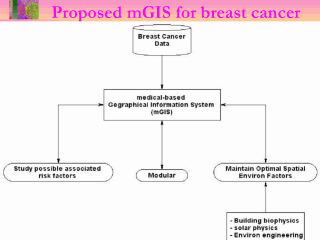 |
The
specific objectives of this application are to:
Explore conceptually how a GIS application could further the risk
factors reduction associated with breast cancer.
Maintain an optimal spatial environmental factors where the cancer
risks to develop is higher. This can be manage by aid of some techniques
like building biophysics, solar physics and environmental engineering.
Is modular and well commended so others can continue to develop it
(e.g. exploring different disease associated with spatial environmental
factors) as well as the possible integration with other software.
Based on the nature of the data and the objectives, we identified
three areas where GIS application could potentially further the breast
cancer analysis:
Mapping and display of data. Analysis, presentation, and
communication of the data are critical. This process requires an
understanding of concepts and methods for determining scale, data
aggregation, visual design, layout and scope of contents.
Revealing patterns within migration events. One of the great
advantages of a GIS application is that allows structured yet rapid access
to a multitude of data. This greatly facilitates the process of spotting
trends within data and correlation with other factors.
Exposure to GIS software. The capabilities, limitations and interface
of GIS software could be enhanced to meet with medical demands.
|
